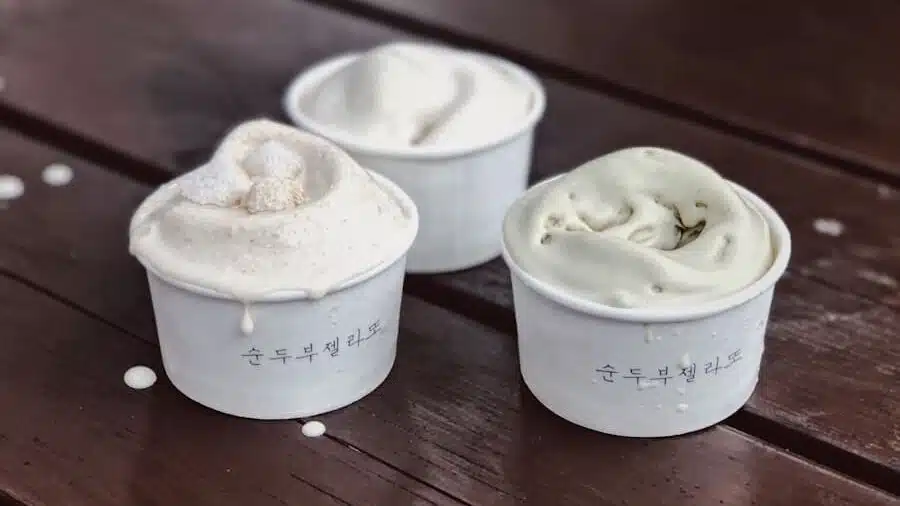
Turkish Ice Cream Guide: Flavors and Where to Try It
Introduction & Overview
What Is Turkish Ice Cream? A Complete Guide to Dondurma
Turkish ice cream, known locally as dondurma, is a traditional frozen dessert famous for its unique chewy texture and remarkable elasticity. Unlike regular ice cream, Turkish ice cream is thickened with salep, a flour made from the tubers of wild orchids, and flavored with mastic for a subtle, aromatic taste. Served in cones or cups, it’s as much about the taste as the theatrical way it’s presented.
Table Of Content
- Introduction & Overview
- What Is Turkish Ice Cream? A Complete Guide to Dondurma
- What Does Turkish Ice Cream Taste Like?
- Why Turkish Ice Cream Is Famous Worldwide?
- History & Unique Features
- The Origins of Turkish Ice Cream and Its Cultural Significance
- Why Turkish Ice Cream Is So Stretchy
- Salep Ice Cream: The Secret Behind Its Unique Texture
- From “Dondurmada” to Dessert Art: The Story Behind the Name
- Ingredients & Preparation
- Turkish Ice Cream Ingredients Explained
- What Is Turkish Ice Cream Made Of? Salep, Mastic, and More
- How to Make Turkish Ice Cream at Home Step-by-Step
- Serving Style & Experience
- The Fun Tradition of Turkish Ice Cream Vendors
- The Street Show: How Turkish Stretching Ice Cream Is Served
- Cream Turkish Style Desserts to Try with Dondurma
- Where & How to Enjoy
- Where to Buy Turkish Ice Cream in Turkey and Abroad
- Best Ice Cream Turkey Shops and Street Stalls
- Must-Try Turkish Ice Cream Flavors
- Comparisons & Variations
- Turkish Ice Cream vs. Regular Ice Cream: What’s the Difference?
- Turkish Ice-Cream Around the World: How It’s Adapted
- Regional Variations in Ice Turkish Desserts
- Related Posts
What Does Turkish Ice Cream Taste Like?

The flavor of Turkish ice cream is creamy, slightly chewy, and subtly floral thanks to the salep and mastic combination. Depending on the vendor, you can find it in classic flavors like pistachio, chocolate, and vanilla, or in fruity variations like strawberry and mulberry. Its chewiness makes it melt more slowly than regular ice cream, giving you more time to savor each bite.
Why Turkish Ice Cream Is Famous Worldwide?

Turkish ice cream has become world-famous not just for its taste, but also for the playful street performances by vendors. These shows—full of tricks, spins, and fake hand-offs—have become a cultural icon. Videos of Turkish ice-cream vendors have gone viral online, attracting tourists from all over the globe to try it in person.
History & Unique Features
The Origins of Turkish Ice Cream and Its Cultural Significance

Turkish ice cream originated in the Kahramanmaraş region of Turkey, where the cold climate and availability of salep created the perfect environment for this dessert. Over time, it became a staple of Turkish street food culture and a must-have experience for visitors.
Why Turkish Ice Cream Is So Stretchy

The stretchiness of Turkish stretching ice cream comes from its high salep content. Salep contains glucomannan, a natural thickening agent that gives the ice cream its chewiness and elasticity. This allows vendors to perform their famous pulling, twirling, and stretching tricks.
Salep Ice Cream: The Secret Behind Its Unique Texture

Salep ice cream is made by combining milk, sugar, salep powder, and sometimes mastic. The mixture is churned and pounded, giving it a dense yet creamy consistency. Because salep is rare and expensive, authentic salep ice cream is considered a premium treat.
From “Dondurmada” to Dessert Art: The Story Behind the Name
In Turkish, “dondurmada” means “in ice cream” or “about ice cream.” Vendors have turned selling dondurma into a form of performance art, transforming a simple purchase into an unforgettable cultural moment.
Ingredients & Preparation
Turkish Ice Cream Ingredients Explained
The key Turkish ice cream ingredients are milk, sugar, salep, and sometimes mastic. The milk is typically full-fat for a rich flavor, while salep provides the chewiness and mastic adds a pine-like aroma.
What Is Turkish Ice Cream Made Of? Salep, Mastic, and More
Authentic Turkish ice cream is made from:
- Fresh whole milk – Provides a rich, creamy base.
- Granulated sugar – Adds sweetness and helps balance the flavors.
- Salep powder (orchid root flour) – Gives the ice cream its signature stretchy texture and chewiness.
- Mastic (optional, for aroma) – Lends a subtle pine-like fragrance and unique taste.
- Pistachios or other nuts (optional) – Commonly used as a topping or mix-in for extra flavor.
- Natural flavorings like rosewater, vanilla, or fruit purees – Add variety and regional flair.
- A pinch of salt – Enhances the overall flavor profile.
How to Make Turkish Ice Cream at Home Step-by-Step
- Warm fresh whole milk and granulated sugar in a heavy-bottomed pot over medium heat, stirring until the sugar is fully dissolved.
- Slowly whisk in salep powder a little at a time to avoid lumps, ensuring it is fully incorporated before adding more.
- Add mastic if desired, crushing it into a fine powder beforehand to release its aromatic oils.
- Continue cooking the mixture while stirring constantly until it thickens into a custard-like consistency — this can take 10–15 minutes.
- Remove from heat and allow it to cool completely at room temperature, then transfer to the refrigerator for at least 2 hours to chill.
- Pour into a freezer-safe container and freeze, stirring vigorously every 30–45 minutes for the first 3–4 hours to develop a smooth, stretchy texture.
- Once firm, serve immediately or store in the freezer, letting it soften for a few minutes before scooping.
Serving Style & Experience
The Fun Tradition of Turkish Ice Cream Vendors
Buying ice cream Turkish style is as much about the show as the dessert. Vendors wear Ottoman-style costumes and perform playful tricks with long-handled paddles before finally handing you your cone.
The Street Show: How Turkish Stretching Ice Cream Is Served
The serving of Turkish stretchy ice cream involves constant teasing of the customer—handing the cone, then whisking it away, flipping it upside down, and spinning it. This interactive style has become an Instagram-worthy experience.
Cream Turkish Style Desserts to Try with Dondurma
Cream Turkish style desserts like künefe, baklava, and kadayıf pair perfectly with dondurma. The creamy, cold ice cream balances the warm, syrupy pastries.
Where & How to Enjoy
Where to Buy Turkish Ice Cream in Turkey and Abroad
You can find Turkish ice cream at street stalls, tourist areas, and specialty dessert shops throughout Turkey.
In Istanbul:
- Sultanahmet: Hafız Mustafa, Mado, and traditional street vendors in Sultanahmet Square performing signature serving tricks.
- Fatih: Local family-run dessert shops like Özkonak and historic parlors near Vefa.
- Kadıköy: Artisanal ice cream spots in the market area, such as Yaşar Usta and Baylan, known for their creative flavors.
Other Cities in Turkey:
- Antalya: Dondurma Dükkanı in Kaleiçi (Old Town) and vendors along the marina.
- Izmir: Ice cream stands on Kordonboyu promenade and Sevinç Pastanesi in Alsancak.
- Kahramanmaraş: Famous for its authentic Maraş dondurması at shops like Mado’s flagship.
Abroad, Turkish and Middle Eastern markets often sell it in tubs, while some specialty restaurants recreate the vendor experience for events and festivals.
Best Ice Cream Turkey Shops and Street Stalls
Some of the best ice cream Turkey spots are in Kahramanmaraş, Istanbul’s Sultanahmet Square, and Antalya’s Old Town. These vendors often blend authenticity with elaborate performances.
Must-Try Turkish Ice Cream Flavors
Popular Turkish ice cream flavors include:
- Pistachio – A classic favorite with a nutty, slightly sweet flavor.
- Chocolate – Rich and indulgent, pairing perfectly with chewy dondurma texture.
- Vanilla – Smooth and creamy, highlighting the salep’s unique chewiness.
- Mulberry – Fruity and slightly tart, popular in summer months.
- Honey & Almond – Sweet, nutty, and aromatic, often drizzled with extra honey.
- Rosewater – Floral and refreshing, offering a traditional Middle Eastern twist.
- Strawberry – Fresh and tangy, ideal for a lighter, fruit-forward option.
- Coffee – Bold and aromatic, a great pick for caffeine lovers.
- Caramel – Sweet and buttery, balancing well with the dense texture.
- Mixed Nuts – Combines pistachios, walnuts, and hazelnuts for a crunchy contrast.
Comparisons & Variations
Turkish Ice Cream vs. Regular Ice Cream: What’s the Difference?
Turkish ice cream is denser, chewier, and melts more slowly than regular ice cream, giving it a distinctive mouthfeel and longer-lasting enjoyment on hot days. The main difference is the use of salep and the pounding method during preparation, which create its elastic, stretchy consistency.
| Feature | Turkish Ice Cream (Dondurma) | Regular Ice Cream |
|---|---|---|
| Texture | Dense, chewy, and stretchy | Smooth, creamy, and soft |
| Key Ingredient | Salep (orchid root flour) | Cream or milk with stabilizers |
| Melting Speed | Very slow due to salep and texture | Faster, especially in warm climates |
| Preparation Method | Pounded and stretched to develop elasticity | Churned for a light, airy texture |
| Serving Style | Often with vendor tricks and performances | Scooped directly into cone or cup |
| Flavor Profile | Creamy with subtle floral or herbal notes (mastic, salep) | Sweet and dairy-forward, often vanilla-based |
Turkish Ice-Cream Around the World: How It’s Adapted
Outside Turkey, Turkish ice-cream is often made without real salep due to strict export restrictions that protect the endangered wild orchids from which salep is derived. As a result, many producers use cornstarch or other plant-based thickeners as substitutes, which can mimic some of the texture but lack the same elasticity and flavor complexity. This substitution slightly alters the chewiness and aroma of the ice cream, making it different from the authentic version found in Turkey.
Regional Variations in Ice Turkish Desserts

In some regions, ice Turkish desserts are served with local toppings like nuts, fruit syrups, or even Turkish delight, creating unique variations that reflect the local culture and available ingredients. For example, along the Black Sea coast, hazelnuts and blackberry syrup are popular, while in southeastern Turkey, crushed pistachios and rosewater syrup are common additions. These toppings not only enhance the flavor but also add texture, turning a simple serving of dondurma into a distinctive regional specialty.

